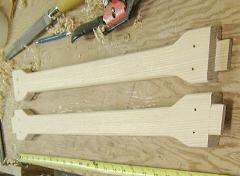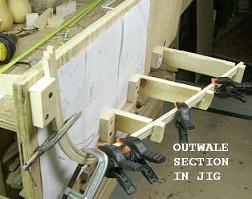Building the Paper Tcîmânens
Constructing the basic wooden parts


|
STEM:
Following the sketch in Addney a jig was build to form
steamed basswood strips into the stem pieces. In order
to follow the complex form the basswood was cut into
approximately 1/16" thick strips 1/2" wide. After drying
within the jig the strips are glued and returned to the
jig while the glue dries. Shown above without lashings.
MANBOARD: The manboard is cutout from 3/8" pine and the two holes sized to accept the stem and brace. A notch is cut at the bottom to attach to the stem foot. Four small holes are required for lashings. The completed stem piece contains the stem piece, manboard, and the center brace. It is approximately 1/2" by 3/4" in cross section and about 6" by 18" overall. In the photo above the notches to receive the inwales has not been cut yet. |


|
THWARTS: Thwarts are from ash. The shape of the thwarts follow the thwarts used in canoes of the same period as the canoe being used as a guide here. As this canoe will be paddled solo with a double paddle, the paddler will occupy the center of the canoe so four thwarts are used; two spaced near the center fore and aft of the paddler plus two near the ends. The end thwarts also serve as handles and tie down points. |

|
OUTWALES: The basswood outwales (narrow strips that run along the outside of the canoe upper edge) are made up from 3 lengths that are scarf joined together. As the ends of the outwales are highly bend the bow and stern end pieces are laminated then steam and bent before being spliced into the longer lengths of outwales. A jig was constructed to aid in bending the laminates both vertically and outward at the same time. The outwales are 3/4" by 3/8" in cross section. |

|
INWALES: The inwales (inside pieces running along the upper edge) are not nearly as bent on the end as the outwales. The ends were also laminated and bent on the same (modified) jig as the outwales. The inwales are 1" by 3/4" with the inner edge beveled to receive the rib ends. The inwales are tapered as they near the stems. Each are mortised in four places to receive the thwart tendons. |

|
SHEATHING: The pieces used for sheathing are milled from basswood. The sheathing is 1/4" - 1/8" thick and range from 1 1/4" to 1 1/2" wide. The 1/4" sheathing is used in the center section between the main thwarts to add support in the area that the paddler will standing in. Each end of the sheathing is taper to a thin edge to overlap the joining piece. The sheathing is butt joined along the edges, not over lapped. |

|
RIBS: Lengths of ash are split into smaller sections that can be milled on the band saw into slabs that can further be cut into slats that are used for the ribs. Thirty one ribs are required; at the center of the canoe they are 1/4" thick but nearer the stems the rib thickness is reduced to 3/16". At their center the ribs are 1 1/2" wide. The ribs taper down to 1 1/4" wide towards their ends. At the end of the ribs they are beveled crosswise to fit into the bevel under the inwales. |

|
PREPARING THE RIBS: The ash ribs are first soaked in a hot water trough then steamed in the steamer before bending. | ----

|
BENDING THE RIBS: The ribs are bent with the aid of a steel strap on which are two end blocks. The blocks have notches that catch the ends of the ribs. The two blocks are spaced 1/8 inch shorter than the ribs. On bending the blocks put the ribs under compression while the strap helps prevent the outer surface from fracturing. |

|

|
| GUNWALE CAPS: The gunwale caps protect the lashings mainly from the paddle. Three sections of ash are spliced together to make up the caps. The cap end sections and the center sections are prebent. Caps are 1 1/4 " by 1/4" and are tapered as they near the stems. Ash is being used for its superior abrasive resistance. | |